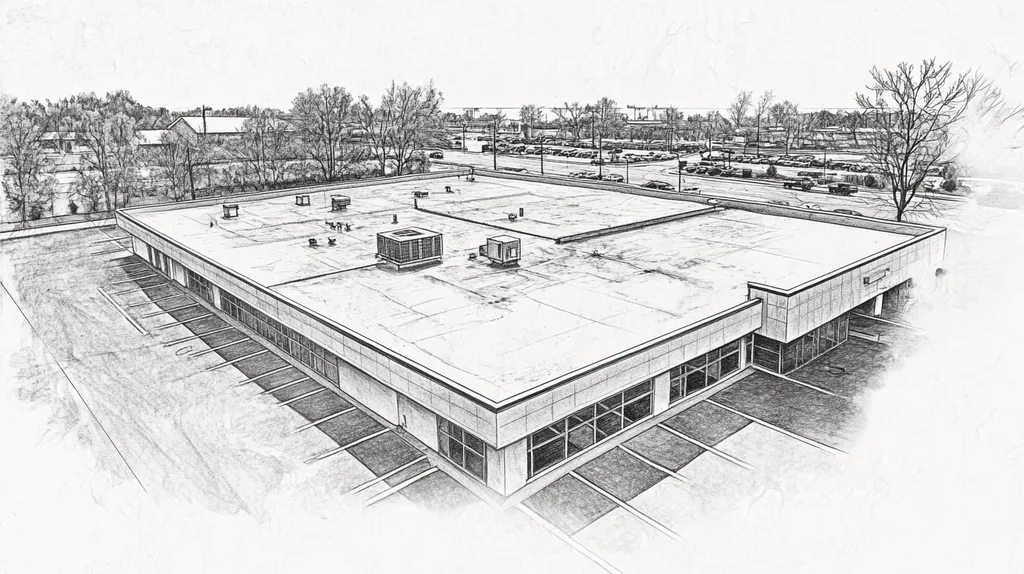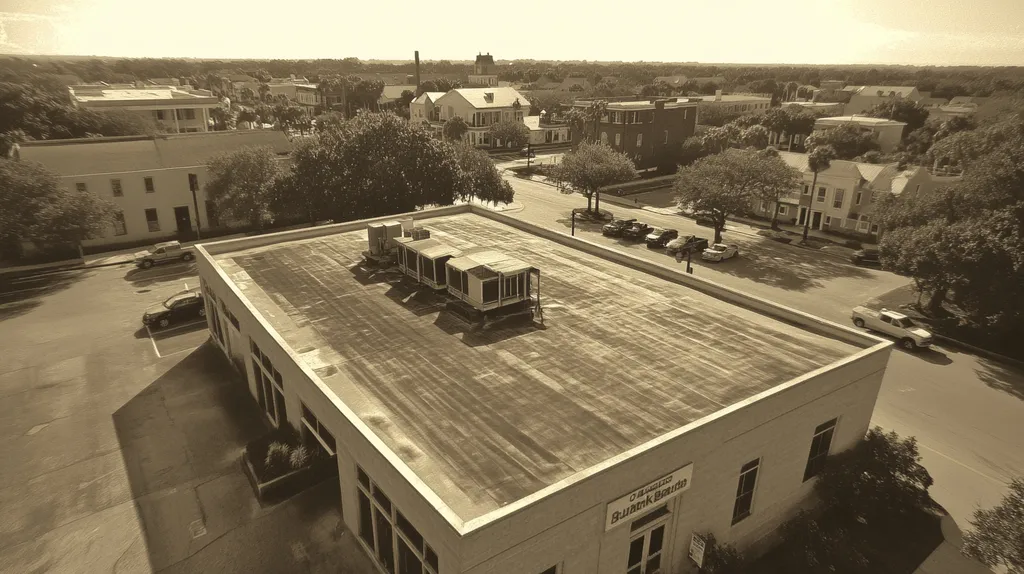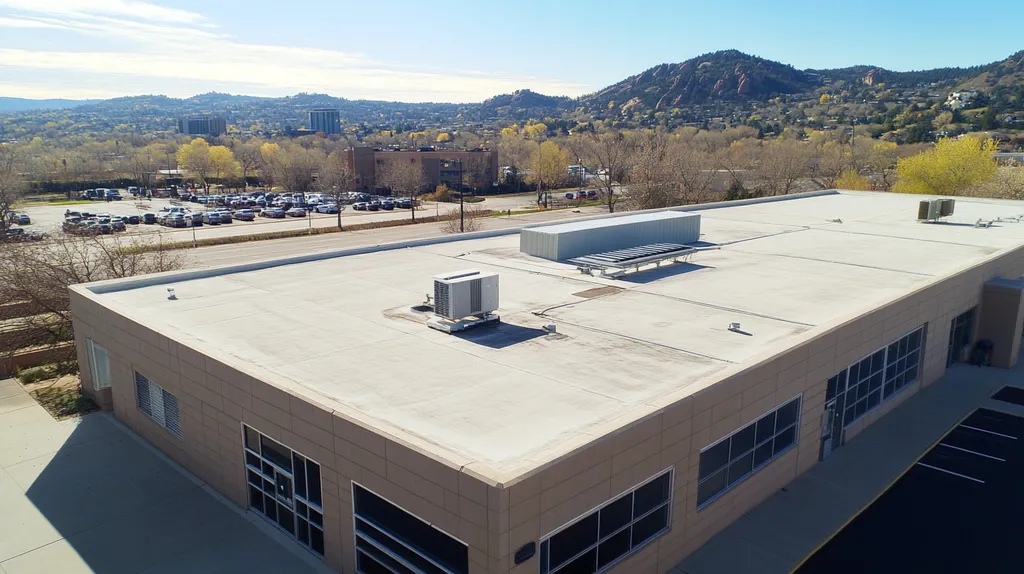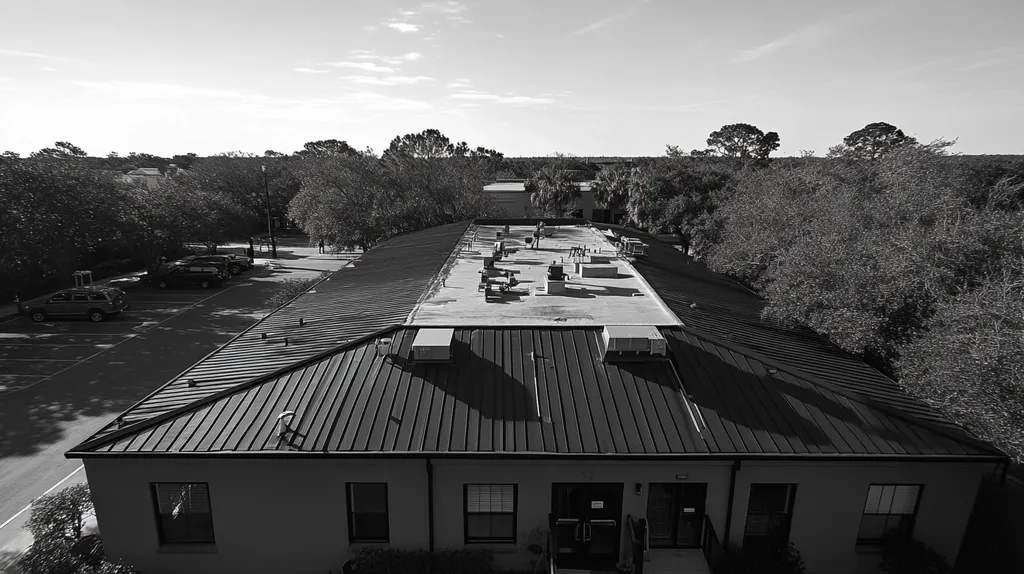In industrial roofing, timing is everything. Studies show that poorly timed repairs can increase project costs by 40-60% while reducing roof lifespan by up to 15 years.
From temperature-sensitive adhesives to moisture-vulnerable membranes, every component of an industrial roof system demands precise timing for optimal repair outcomes.
This comprehensive guide examines the critical factors that determine the best timing for industrial roof repairs, including seasonal impacts, material behavior, and operational considerations that directly affect repair success rates.
SECTION 1: FUNDAMENTAL CONCEPTS
Industrial roof repairs require precise timing to maximize effectiveness and minimize costs. Studies show that poorly timed repairs can increase project expenses by 40-60% due to weather complications and material compatibility issues. Understanding the complex interplay between seasonal conditions, material properties, and roof lifecycle stages is crucial for making informed repair decisions that protect both the facility and bottom line.
Seasonal Weather Impacts on Industrial Roofs
Winter conditions pose significant challenges for industrial roof repairs, as cold temperatures prevent proper material adhesion and sealing. Summer and fall typically offer the most favorable conditions for roofing work, allowing materials to cure properly and crews to work efficiently. (source: JobNimbus)
Spring brings frequent rain events that can interrupt repair work and compromise newly installed materials. Property managers must carefully balance urgent repair needs against weather-related risks during this season.
High summer temperatures can cause thermal expansion that stresses existing roof systems, particularly around joints and transitions. This makes early summer an ideal time for preventive maintenance before peak heat arrives.
Fall’s moderate temperatures and typically stable weather patterns create excellent conditions for major repair projects. However, work should be scheduled early enough to ensure completion before winter weather arrives.
Material Response to Thermal and Moisture Cycles
Industrial roofing materials expand and contract with temperature changes, creating stress on seams and flashings. These thermal cycles can cause materials to separate from substrates or develop micro-cracks that allow moisture infiltration.
Different roofing systems exhibit varying levels of dimensional stability. Single-ply membranes may require more frequent maintenance at terminations and penetrations, while built-up systems typically show better resistance to thermal movement.
Moisture trapped within roof assemblies can degrade insulation performance and accelerate material breakdown. Regular infrared scanning can identify wet areas before they cause widespread damage.
UV exposure gradually degrades most roofing materials, with damage accelerating during hot summer months. Protective coatings applied during optimal weather conditions can extend material lifespan significantly.
Timing Roof Repairs According to Roof Life Cycle
The first five years of a roof’s service life typically require minimal repairs when properly installed. This period provides an opportunity to establish baseline performance data and identify any installation-related issues.
Years 5-15 often see increasing maintenance needs as materials age and weather exposure takes its toll. Addressing minor issues promptly during this phase can prevent more costly repairs later.
The final third of a roof’s service life demands careful cost-benefit analysis for each repair. Investment in major repairs may be wasteful if complete replacement is imminent within 2-3 years.
Strategic timing of repairs within the lifecycle can extend roof longevity by 5-10 years. This requires balanced consideration of current condition, remaining service life, and facility operational requirements.
SECTION 2: SYSTEM COMPONENTS
Industrial roofing systems represent significant capital investments, with component failures potentially causing millions in damage. Understanding how each element responds to seasonal changes is crucial for timing repairs effectively. Research shows that properly timed maintenance of key components can extend a roof’s lifespan by up to 40%, while misaligned repair schedules often lead to premature system failure and unexpected capital expenditures.
Key Roofing Membranes and Their Repair Windows
Industrial roofing membranes serve as the primary waterproofing barrier, with each type requiring specific maintenance timing. TPO and PVC membranes become more pliable in warmer temperatures, making spring and early summer ideal for seam repairs.
EPDM rubber roofing demonstrates superior durability but requires careful attention to seam adhesion. Membrane repairs performed during temperature extremes often fail prematurely due to thermal stress and improper curing.
Built-up roofing systems need consistent maintenance to prevent delamination and blistering. Early detection and repair of membrane defects prevent moisture infiltration that can compromise entire roof sections.
Timing membrane repairs during moderate temperatures ensures proper material bonding and reduces the risk of installation defects that could void manufacturer warranties.
Critical Flashings, Seals, and Penetration Vulnerabilities
Roof penetrations and their associated flashings represent the most vulnerable points in any industrial roofing system. Each penetration creates potential water entry points that require regular inspection and maintenance.
Metal flashings expand and contract significantly with temperature changes, making spring and fall ideal for repairs. Proper timing prevents thermal movement from compromising newly installed materials.
Seal failures around HVAC units, pipes, and other roof penetrations account for over 60% of industrial roof leaks. Regular inspection of these components helps identify deterioration before water damage occurs.
Installation of new flashings and seals during fall’s moderate temperatures provides optimal conditions for material adhesion and long-term performance. (source: Tema Roofing Services)
Drainage Systems and Their Role in Repair Timing
Effective drainage systems prevent ponding water that can stress industrial roofing components and accelerate deterioration. Regular maintenance of drains, scuppers, and downspouts is essential for system longevity.
Internal drain systems require inspection before winter to prevent ice damming and backing up. Addressing drainage issues during dry weather allows for thorough cleaning and repair of compromised components.
Proper slope and drainage patterns significantly impact membrane performance and longevity. Correcting drainage problems during optimal weather conditions ensures proper water flow and reduces the risk of future leaks.
Annual drainage system maintenance, timed before heavy rain seasons, prevents emergency repairs and protects the entire roofing system from water-related damage.
SECTION 3: IMPLEMENTATION METHODS
Successful industrial roof repairs demand precise implementation strategies that balance weather conditions, damage assessment, and operational continuity. Studies show that improper repair timing and inadequate assessment lead to 65% higher costs and shortened roof lifespans. Understanding optimal repair windows, thorough evaluation methods, and strategic scheduling can mean the difference between a long-lasting solution and recurring problems that drain facility budgets.
Optimal Weather Conditions for Roof Repair Work
Temperature and moisture levels significantly impact repair success rates. Most roofing materials require temperatures between 40-85°F for proper adhesion and curing, while excessive humidity can compromise material bonds and lead to premature failures.
Spring is ideal for industrial roofing repairs in drier climates, while summer work proves more successful in regions with moderate temperatures and lower rainfall. Fall offers another prime repair window, allowing completion before winter weather arrives, while winter repairs generally succeed only in mild climate zones. (source: AAA Roofing)
Wind conditions also play a crucial role in repair timing. Strong winds can compromise worker safety and prevent proper material installation, particularly with single-ply membranes and adhesive-based systems.
Material-specific temperature requirements must guide scheduling decisions. For instance, thermoplastic materials need warmer conditions for proper heat welding, while certain sealants require cooler temperatures to achieve optimal cure rates.
Methods for Damage Assessment and Prioritization
Comprehensive damage assessment begins with systematic visual inspections of all roof components. Special attention must focus on areas around penetrations, mechanical equipment, and previous repairs where most leaks originate.
Modern assessment tools like moisture meters and thermal imaging cameras help identify hidden damage beneath the surface. These technologies can detect moisture infiltration before visible signs appear, enabling proactive repairs.
Documentation of all findings creates a clear repair priority framework. Critical issues threatening structural integrity or operational continuity demand immediate attention, while less urgent repairs can be scheduled during optimal weather windows.
Regular assessment intervals should align with seasonal changes and following severe weather events. This systematic approach prevents minor issues from escalating into major problems requiring extensive repairs.
Scheduling Repairs to Minimize Operational Disruption
Strategic repair scheduling requires close coordination between facility operations and roofing contractors. Planning work during planned shutdowns or lower-activity periods minimizes impact on daily operations while ensuring adequate time for proper installation.
Breaking larger repair projects into manageable phases helps maintain facility functionality. Each phase should have clear completion criteria and contingency plans for weather delays or unexpected conditions.
Communication protocols must keep all stakeholders informed about repair timing and potential disruptions. Clear signage, regular updates, and designated points of contact help maintain smooth operations during repair work.
Emergency repair procedures should be established in advance to address sudden leaks or storm damage. These protocols ensure rapid response while maintaining safety standards and minimizing operational impact.
SECTION 4: MAINTENANCE REQUIREMENTS
Industrial roof maintenance represents a critical investment in facility protection, with studies showing that preventive maintenance programs can extend roof life by up to 300%. Yet over 80% of industrial roofs fail prematurely due to inadequate maintenance protocols. The direct costs of neglected maintenance often exceed $5 per square foot annually when accounting for energy loss, interior damage, and accelerated deterioration. Understanding and implementing proper maintenance requirements is essential for protecting both the roofing asset and the facility it shields.
Seasonal Inspection Protocols and Checklists
Every industrial roof requires comprehensive inspections at least twice annually, with timing based on regional climate patterns. The most effective inspection programs divide roofs into zones, systematically examining each area for specific defects.
Essential inspection points include membrane condition, flashing integrity, drainage pathway clearance, and signs of ponding water. Documentation must include detailed photos and measurements of any observed deficiencies.
Modern inspection tools like infrared scanning and moisture mapping provide crucial data about subsurface conditions. These technologies can detect hidden moisture infiltration months before visible damage appears.
Building a historical database of inspection findings enables facility managers to track deterioration patterns and optimize repair timing. This data-driven approach transforms reactive maintenance into strategic asset management.
Proactive Leak Detection and Immediate Repair Practices
Early leak detection drastically reduces repair costs and prevents collateral damage to building interiors. Electronic leak detection systems can pinpoint water entry points with remarkable accuracy, even in large industrial facilities.
Response protocols must specify maximum allowable times between leak discovery and repair initiation. Even minor leaks can saturate insulation and compromise structural elements if left unaddressed.
Maintaining an on-call relationship with qualified roofing contractors ensures rapid response to emergency situations. This partnership should include pre-negotiated rates and guaranteed response times.
Staff training in basic leak identification and temporary containment measures provides crucial first-response capabilities. This knowledge can prevent extensive damage during the critical period before professional repairs begin.
Maintaining Roof Coatings and Protective Treatments
Protective coatings serve as sacrificial wear layers that shield underlying roofing materials from UV radiation and weather exposure. Regular coating maintenance can double or triple the service life of many industrial roofing systems.
Coating inspections should evaluate surface integrity, adhesion, and remaining thickness. Areas showing accelerated wear or damage require prompt recoating to maintain protection.
Spring is ideal for industrial roofing coating applications in drier climates, while fall timing works better in regions with wet springs. Proper timing ensures optimal curing conditions and maximizes coating performance. (source: AAA Roofing)
Selection of coating systems must consider facility operations, local climate conditions, and existing roof substrate compatibility. High-quality coatings may cost more initially but deliver superior long-term protection and value.
SECTION 5: PERFORMANCE METRICS
Industrial roof performance metrics directly impact facility operations and bottom-line costs. Studies indicate that systematic performance tracking can reduce lifetime roofing costs by up to 40% while extending service life by 5-7 years. Understanding and monitoring key metrics allows facility managers to make data-driven decisions about repair timing and preventive maintenance investments that protect both the building envelope and operational continuity.
Evaluating Roof Integrity Post-Repair
Post-repair evaluation requires comprehensive testing of membrane adhesion, seam integrity, and moisture penetration. Advanced moisture detection methods like nuclear scanning and electrical impedance testing can verify repair effectiveness before visible leaks develop.
Core sampling at repair boundaries confirms proper material integration and identifies potential weak points. These samples must be properly patched to maintain system integrity.
Digital documentation of repair locations, including detailed photographs and thermal imaging, creates a baseline for future performance comparison. This data helps identify patterns of premature failure or recurring issues.
Regular pull tests on repaired areas verify long-term adhesion strength and highlight any degradation in repair materials. Early detection of failing repairs prevents cascade failures that compromise larger roof sections.
Monitoring Material Degradation Rates by Season
Spring, early summer, and fall provide optimal conditions for assessing material performance and completing necessary repairs. Regular monitoring during these periods helps establish degradation patterns and predict maintenance needs. (source: ServiceTitan)
Surface erosion measurements taken at fixed points track wear rates across different exposures. Areas showing accelerated degradation may require additional protective measures or modified repair schedules.
Membrane thickness measurements at critical points identify areas of excessive wear before failure occurs. This data guides timing of coating applications and reinforcement installations.
Chemical analysis of material samples can detect early signs of polymer breakdown or plasticizer loss. Understanding these changes helps optimize repair timing and material selection.
Measuring Energy Efficiency Impact of Timely Repairs
Energy consumption patterns before and after repairs provide concrete metrics for evaluating repair effectiveness. Properly timed repairs can reduce HVAC loads by 15-25% through improved insulation performance and air barrier integrity.
Thermal imaging surveys conducted seasonally identify areas of heat loss or gain through the roof assembly. These scans guide repair prioritization and verify energy performance improvements.
Tracking dewpoint conditions within roof assemblies helps prevent condensation-related damage. Proper repair timing maintains vapor barriers and prevents insulation degradation.
Cost analysis of energy savings versus repair investments supports strategic maintenance planning. This data justifies proactive repairs that maintain peak energy efficiency.
SECTION 6: OPTIMIZATION STRATEGIES
Industrial roof optimization represents a critical intersection of timing, technique, and financial planning. Studies show that strategically timed repairs can reduce lifetime costs by up to 60% while extending roof service life by 8-12 years. However, over 70% of facilities still operate on reactive maintenance schedules, leading to premature system failures and emergency repairs that cost 3-5 times more than planned interventions. Understanding how to align maintenance with seasonal patterns, leverage preventive strategies, and analyze cost-benefit ratios transforms roof management from crisis response to strategic asset preservation.
Aligning Maintenance Schedules with Seasonal Cycles
Temperature fluctuations and weather patterns create distinct windows for effective maintenance throughout the year. Spring inspections should focus on winter damage assessment and preparation for summer heat stress, while fall maintenance prioritizes weatherization before winter arrives.
Major repair projects require careful scheduling around predicted weather patterns. Most adhesives and sealants perform optimally between 50-80°F, making early summer and early fall prime periods for extensive work.
Drainage system maintenance demands particular attention during seasonal transitions. Pre-winter cleaning prevents ice dams, while spring maintenance ensures proper flow during heavy rains.
Equipment-intensive repairs should align with periods of moderate temperatures to minimize thermal stress on newly installed materials. This timing also optimizes crew efficiency and material handling.
Leveraging Preventive Repairs to Extend Roof Lifespan
Regular preventive maintenance can extend industrial roof life by 25-35% compared to reactive approaches. Key focus areas include seam reinforcement, flashing repairs, and surface protection before visible damage occurs.
Infrared scanning during seasonal transitions identifies developing issues before they become critical. This technology enables precise targeting of preventive repairs to high-risk areas.
Surface treatments and protective coatings applied during optimal weather conditions create additional weatherization layers. These treatments prove especially valuable when applied before periods of extreme temperature or precipitation.
Documentation of preventive repairs creates valuable trending data for future maintenance planning. This information helps optimize timing and resource allocation for maximum system longevity.
Cost-Benefit Analysis of Repair Timing and Methods
Strategic timing of repairs typically reduces project costs by 20-30% through improved material performance and labor efficiency. Analysis must consider both immediate repair costs and long-term performance implications.
Emergency repairs often cost 300-400% more than planned maintenance due to expedited material delivery, overtime labor, and potential production disruptions. These costs compound when repairs must be performed under suboptimal conditions.
Life-cycle cost analysis reveals that properly timed preventive repairs typically return $4-6 for every dollar invested. This return comes through extended service life, reduced energy costs, and avoided emergency repairs.
Investment in high-quality materials during optimal installation conditions yields 40-50% longer service life compared to standard materials installed reactively. This differential must factor into repair versus replacement decisions.
The Bottom Line
Industrial roof repairs represent a $12 billion annual investment across U.S. manufacturing and warehouse facilities, with timing mistakes accounting for over $4 billion in preventable waste.
The data is clear: properly timed repairs reduce costs by 40-60% while adding 5-7 years to roof system longevity.
Spring and fall emerge as optimal repair windows, offering ideal temperature ranges of 50-80°F for most roofing materials.
Success requires aligning maintenance schedules with seasonal patterns, leveraging preventive strategies, and conducting repairs during weather-appropriate windows.
Facilities that implement strategic timing protocols consistently achieve 300% longer roof lifespans compared to those operating on reactive maintenance schedules.
FREQUENTLY ASKED QUESTIONS
Q. When is the best time for industrial roof repairs?
A. The best time for repairs is typically during spring and fall. Moderate temperatures and stable weather conditions allow materials to cure effectively, minimizing the risk of premature failures.
Q. How do seasonal changes affect industrial roof performance?
A. Seasonal changes can impact material flexibility and curing times. Improper timing can lead to costly repairs and reduced roof lifespan, so understanding these changes is crucial for maintenance planning.
Q. What are the key components of a commercial roof?
A. Key components include roofing membranes, flashings, and drainage systems. Each part plays a vital role in the roof’s waterproofing and overall functionality, necessitating regular maintenance and timely repairs.
Q. How do I prioritize roof repairs for my industrial roof?
A. Prioritize repairs based on severity and potential impact. Start with critical issues that threaten structural integrity, then address minor repairs during optimal weather conditions to enhance longevity.
Q. How can I measure the performance of my industrial roof?
A. Monitor performance by assessing adhesion strength and inspecting for leaks regularly. Utilize technologies like thermal imaging to identify hidden issues that require timely repairs before they escalate.
Q. What maintenance is required for a commercial roof?
A. Regular inspections, cleaning debris, and addressing minor repairs are essential. Seasonal maintenance aligns with optimal weather conditions to ensure material longevity and prevent unexpected failures.
Q. How often should I inspect my industrial roof?
A. It’s recommended to inspect your roof at least twice a year. Additionally, conduct inspections after severe weather events to catch potential issues early and maintain the roof’s integrity.










